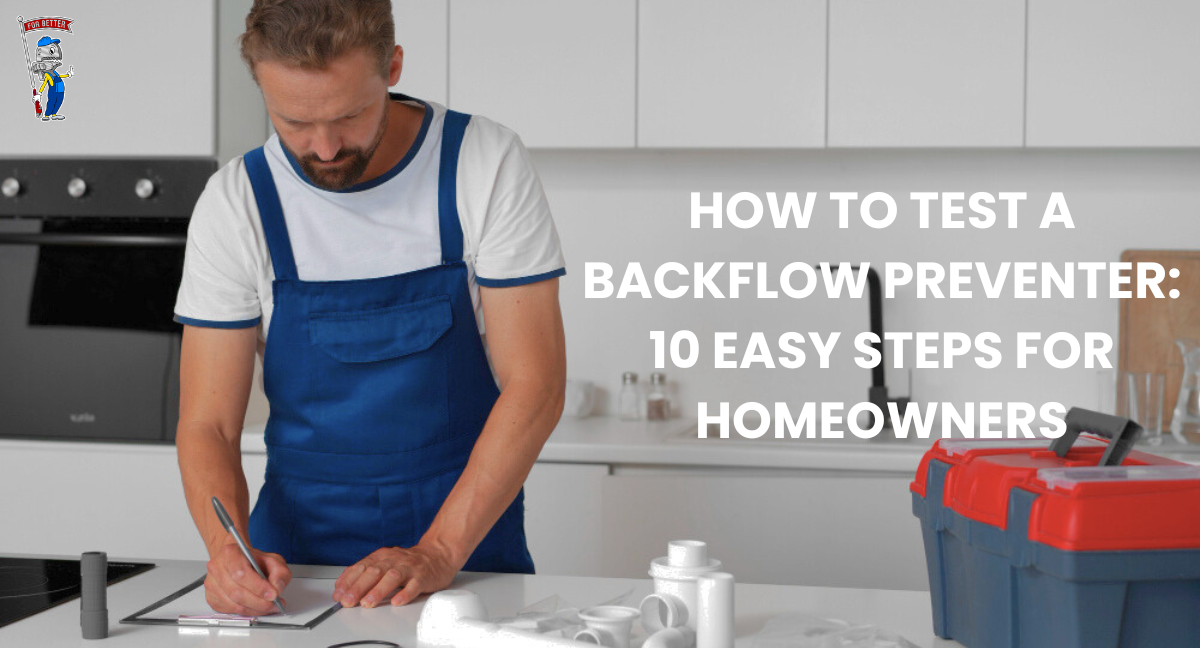How to Test a Backflow Preventer: 10 Easy Steps for Homeowners
Introduction
Backflow preventers play a crucial role in safeguarding our water supply, ensuring contaminants don’t flow back into the main water system. Regular testing of these devices is paramount to maintain water safety and adhere to regulations. In this guide, we’ll explore the process of testing a backflow preventer, highlighting its significance and providing insights into troubleshooting, maintenance, and compliance.
Understanding Backflow Preventers
Backflow preventers, devices installed in plumbing systems, prevent the reverse flow of water. There are various types, such as the pressure vacuum breaker and double check valve, each serving specific purposes. Understanding the different types and where they’re commonly installed is crucial for effective testing.
If you want to know in detail about “What is a Backflow preventer? What are the types of Backflow Prevention Devices and much more” Then, check out our article: “What is a Backflow Prevention Device? Your Comprehensive Guide!” In this article, we have covered everything about Backflow preventers.
Why Testing is Crucial
Regular testing ensures that backflow preventers are functioning correctly. This not only guarantees water safety for consumers but also helps property owners comply with regulations. By identifying potential issues early on, testing becomes a proactive measure to prevent water contamination.
How to test a Backflow Preventer: In-Depth Guide
Ensuring the effectiveness of a backflow preventer is not only a matter of compliance but also a critical step in maintaining the purity of our water supply. Let’s break down the testing process into more detail to empower you with a comprehensive understanding.
1.) Gather Necessary Tools:
Before initiating the testing process, it’s crucial to have the right tools at your disposal. In addition to a pressure gauge, hose bibb pressure gauge, and a flat-head screwdriver, consider having a bucket and a towel on hand to manage any water spillage.
2.) Locate the Backflow Preventer:
Identifying the precise location of the backflow preventer is essential. It’s commonly found near the water meter or at the point where the main water supply enters your building. If you’re uncertain about the location, contact Baumbach Plumbing & Remodeling: Our professional experts will help you identify the location of the backflow preventer.
3.) Shut Off the Water Supply:
Turning off the main water supply is a critical safety measure. This not only prevents potential water waste but also ensures a controlled environment for accurate testing.
4.) Release Pressure:
Open a nearby faucet or hose bibb to release any remaining pressure in the system. This step is vital to creating a baseline for testing and avoiding unexpected issues during the procedure.
5.) Remove Test Port Covers:
Most backflow preventers have test ports covered with caps. Using a flat-head screwdriver, carefully remove these caps. Be cautious not to damage the threads or the port openings in the process.
6.) Connect the Pressure Gauge:
Securely attach the pressure gauge to the test port. Ensure a tight connection to prevent air leaks, as accurate pressure readings are crucial for a successful test.
7.) Perform the Test:
With the pressure gauge in place, slowly turn on the main water supply. Observe the pressure readings on the gauge. Different types of backflow preventers have specific pressure requirements, so refer to the manufacturer’s guidelines to ensure the system is within the recommended range.
8.) Inspect for Leaks:
While the water supply is running, visually inspect the entire backflow preventer for any signs of leaks. Pay close attention to joints, connections, and the body of the device. Address any leaks promptly, as they can compromise the effectiveness of the backflow preventer.
9.) Perform Visual Checks:
Take the time to visually inspect all components of the backflow preventer. Look for rust, corrosion, or any visible damage. Ensure that all valves and check mechanisms are in proper working condition.
10.) Document the Test Results:
Record the pressure readings, any observations made during the test, and details about the condition of the backflow preventer. This documentation serves as a valuable reference for future comparisons and maintenance.
By following this detailed testing guide, you not only ensure the functionality of your backflow preventer but also contribute to the overall safety and quality of your water supply. Regular and meticulous testing is the key to preventing water contamination and promoting the health and well-being of your community.
Frequency of Testing
Industry standards recommend periodic testing, but the frequency depends on factors like the type of preventer and local regulations. Knowing when and how often to test is essential for maintaining a safe water supply.
Benefits of Regular Testing
1. Prevention of Water Contamination:
One of the primary benefits of regular backflow preventer testing is the prevention of water contamination. Backflow, the unwanted reversal of water flow, has the potential to introduce pollutants and contaminants into our main water supply. By conducting routine tests, we identify and address any issues promptly, preventing the contamination of the water we rely on for drinking, cooking, and other daily activities.
2. Compliance with Regulations:
Local and state regulations often mandate regular testing of backflow preventers, particularly in commercial and industrial settings. Adhering to these regulations is not just a legal requirement but a responsibility to the community. Regular testing ensures that your water system meets the necessary standards, contributing to the overall safety and well-being of the public.
3. Prolonged Lifespan of Backflow Preventers:
Just like any mechanical device, backflow preventers can experience wear and tear over time. Regular testing allows for the early detection of potential issues, enabling timely repairs or replacements. This proactive approach helps extend the lifespan of backflow preventers, saving property owners from the inconvenience and cost associated with sudden failures.
4. Cost-Effective Maintenance:
Addressing problems at an early stage is not only beneficial for the backflow preventer but also for your budget. Regular testing and maintenance are generally more cost-effective than dealing with extensive repairs or replacements that result from neglected issues. Investing in preventive measures ultimately saves money in the long run.
5. Protection of Public Health:
Waterborne diseases pose a significant threat to public health, and backflow preventers serve as a crucial line of defense against such threats. Regular testing ensures that these devices are functioning optimally, providing an effective barrier against the infiltration of contaminants. By protecting the purity of our water supply, we contribute to the well-being of individuals and communities.
6. Confidence in Water Quality:
Regular backflow preventer testing instills confidence in the quality of the water we use. Whether at home, in a commercial establishment, or an industrial facility, knowing that proper measures are in place to prevent water contamination fosters trust in the safety of the water supply. This confidence is essential for both property owners and the community at large.
7. Environmental Responsibility:
Water is a precious resource, and safeguarding its quality is an environmental responsibility. Regular backflow preventer testing aligns with sustainable practices by preventing the unnecessary waste of water due to contamination. By ensuring the integrity of our water systems, we contribute to the conservation of this vital resource for current and future generations.
Common Mistakes to Avoid in Backflow Preventer Testing
Neglecting Regular Testing Intervals:
One of the primary mistakes is neglecting the recommended testing intervals. Backflow preventers should ideally be tested annually, as stipulated by regulations and industry standards. Skipping or delaying tests can lead to undetected issues, increasing the risk of water contamination and system failures.
Inadequate Training for Testing Personnel:
Conducting backflow preventer tests requires a certain level of expertise. Inadequately trained personnel may misinterpret readings or overlook critical details during the testing process. It’s essential to ensure that individuals responsible for testing have received proper training and stay updated on industry best practices.
Failing to Document Test Results:
Proper documentation is a key aspect of backflow preventer testing. Failing to record test results, pressure readings, and any observations can hinder the ability to track changes over time. Documentation serves as a valuable reference for future comparisons, aiding in the identification of trends and potential issues.
Ignoring Manufacturer Guidelines:
Different backflow preventers may have unique testing requirements based on their design and specifications. Ignoring or neglecting the manufacturer’s guidelines for testing can result in inaccurate readings and may compromise the device’s ability to prevent backflow effectively. Always refer to the manufacturer’s recommendations during the testing process.
Overlooking Visual Inspections:
A common mistake is focusing solely on pressure readings while overlooking visual inspections. Visual checks for leaks, corrosion, and overall device condition are equally vital. A comprehensive approach that combines both pressure testing and visual inspections ensures a thorough evaluation of the backflow preventer’s health.
Using Incorrect Testing Equipment:
Using the wrong testing equipment can lead to inaccurate readings and misinterpretations. Ensure that the pressure gauge and other tools used for testing are appropriate for the specific type of backflow preventer being assessed. Using outdated or damaged equipment can compromise the reliability of the testing process.
In conclusion, testing a backflow preventer is not just a regulatory requirement but a fundamental step in ensuring the safety of our water supply. Proactive testing, coupled with troubleshooting and maintenance, guarantees the longevity of these devices, providing peace of mind for property owners.



